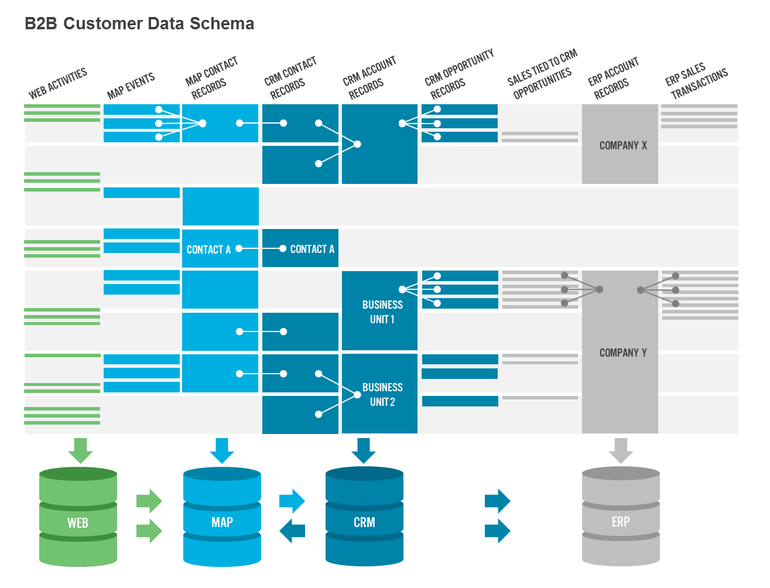Every new digital tool we acquire gathers still more data, yet few are designed to help us unify that data into a meaningful, commonly-understood format.
The result is that while everyone seems to be talking about the power of data, few of us are equipped to really unleash it. The first stage is data unification…
The first part of this article looked at the different scenarios in which businesses collect and use data. The information gathered from events, websites, emails, sales and third parties is all invaluable – but all too often incompatible. To find a solution, we first need to look at how those scenarios impact the data integration layer. Some technologies already mentioned are contact/user ID oriented (MAP for example) and some have both contact and account ID orientation (CRM for example) and others are mainly account ID oriented (ERP for example). This leaves the enterprise with the difficult task of getting the data unified and integrated, never mind trying to make that unified data actionable to operationalize customer engagement strategies, closed loop reporting and buyer journey analysis.
Visualizing the problem
To help understand where the data can be integrated, MarketOne has mapped out a typical B2B customer data schematic based on 4 of the 5 examples we outlined in the first part of the article. Even as complex as the below diagram is, we left out third and second party data services and stayed focused on first party data.
Buyer data comes from many different tools and platforms, which means your data is speaking many different languages that require effort and investment to translate and integrate. Maybe you have attempted to engineer solutions at the application tier only to find that replicating data between MAP, CRM and web further corrupts the data. Or you discover how hard it is to synchronize data while the applications continuously create still more data.
Your data is speaking many different languages that require effort to translate and integrate.

Too much talking, not enough doing
Now that customers have been working with these tools for a while, this problem is starting to come to a head with many of our customers starting to feel new levels of frustration around pulling value out of their marketing technology investments. Too much time and resource is going into making the platform function at the application tier and not enough time focused on why the investment was made in the first place – to create new customer experiences, increase and deepen customer engagement and drive more leads into the sales funnel. As a result we see too many very expensive marketing architectures still batching and blasting, one-size-fits-all form experiences, and marketing databases with a high percentage of dormant or invalid contacts.
All is not lost, there is a solution – but it takes commitment and ongoing rigor to stand it up. Once operationalized, you will see new levels of success in helping to drive sales pipeline. Below are three ideas you should be discussing as an organization in 2016:
1. Pull your data out of your applications to analyze it
You will be amazed what you will find sitting right in front of you. But you can’t do this alone – you need a partner that has tools to rapidly extract data from your platform and get it unified and aligned for marketing analysis quickly. Most marketers don’t have the
time or budget to try and do this in house. Also, don’t try to boil the ocean across all the platforms. This is the biggest mistake made by internal projects, because marketing gets the sense that they have only one opportunity to get IT to help them. Better to start with MAP and CRM – learn what you have and how to measure it, then maybe pull in Web Analytics or purchase history from ERP. You will be amazed at what you will find in terms of buying patterns, customer segments and propensity models that can be used to drive quick win marketing campaigns and lead scoring adjustments based on your own first party data.
The key to an effective marketing data services layer is getting data back into the transactional applications where it can actually be used.
2. Use the database as your incubator for creating new data and new intelligence
This is typically where internal data warehouse projects can’t move fast enough for marketing. Marketing’s success is about its ability to sense and respond to buyer behavior, which requires more than just a one-way extract and ETL to support static reporting. The power of a true marketing data services layer is getting data back into the transactional applications (MAP/CRM) where it can actually be used. The focus needs to be around how you can provide value back to MAP and CRM. Examples of data services include:
Database Health – governing your data inputs
- Are your contacts complete?
- Is your data aligned to your desired rules for lead scoring?
- Does the lack of health highlight gaps in process with new lead acquisitioninto the platform and sales generated data?
- Are all buyer transactions aligned and accounted for to drive an activity profile – inbound vs. outbound – marketing vs. sales vs. customer service. Can you interpret activity at the account view vs. the contact view vs. a buying team view?
Buyer Segments – understanding the buyer across a history of both sales and marketing data
What kind of marketing engagement are you really creating – prospect
accounts vs. active customers?
Many clients think a scoring program will solve their qualified lead problem – when in fact the problem is lack of understanding buyer engagement and how that converts into a meaningful sales conversation.
Use data to refine your sales and marketing lead management taxonomy –this will make you think differently about the lead management process and how to measure it.
Analyze how effective your inbound and outbound marketing channels are at creating leads and keeping buyers engaged.
Stand up an Account Based Marketing (ABM) strategy – data is the biggest barrier to ABM. Your marketing data services layer will be able to measure and trigger communications that take both organization and contact profiles into account.
Campaign/activity analysis
Start looking at campaigns through the lens of benchmarks and customer engagement. Stop trying to link every marketing interaction to pipeline or revenue – but instead analyze your data to understand cause and effect against desired outcomes. Examine your data like a scientist.
As you start to understand the underlying data being generated and how it fits into a buyer profile, you can re-define a campaign vs. program vs. tactic vs. asset. That will create guidelines for how to measure marketing effectiveness against an appropriate outcome and compare across messaging, segment and persona groupings.
3. Realize that you need to create a unique data service for marketing
It needs to be agile, capable of driving automation and put actionable information in the hands of your marketing experts to execute better planning and strategy. You will open up a whole new world of marketing communications and start speaking to the customer based on where they truly are in a buying cycle – not just communicating and measuring against the last touch.
It’s time for data to come out of the shadows
Data is perhaps the most under-invested area of marketing today – which is astonishing since the quality and accessibility of data will dictate the success of most digital marketing activities.Maybe the reason is that data doesn’t have the instant appeal of the latest, shiniest marketing tech products and, as marketers, we find the idea of an instant solution irresistible.
But if we want confidence in results, we need confidence in our data. And it is frequently much easier to justify an investment in data services than in yet another piece of tech. Every day there is a new way to apply data, a new tool adding yet another dimension to the customer journey, another logo on the supergraphic. But underneath it all, a solid data strategy is a fundamental requirement to making it all work.


